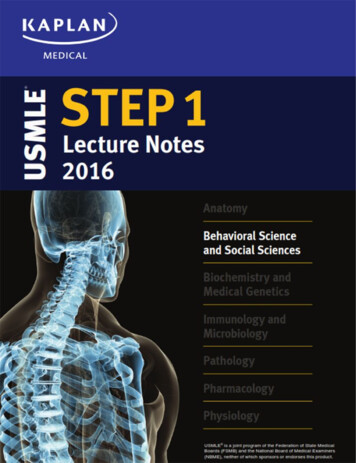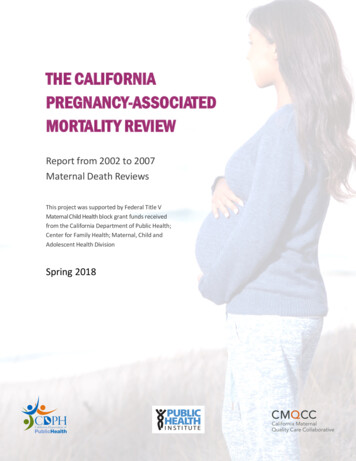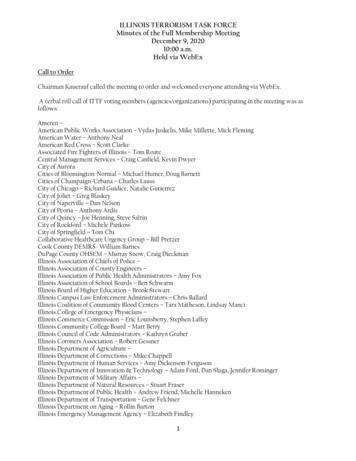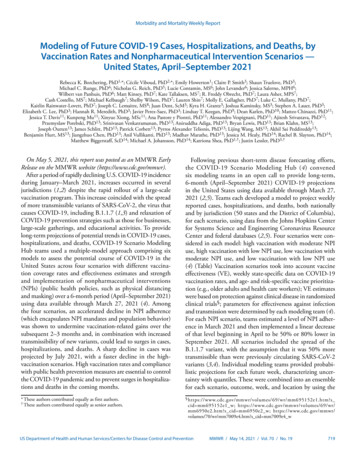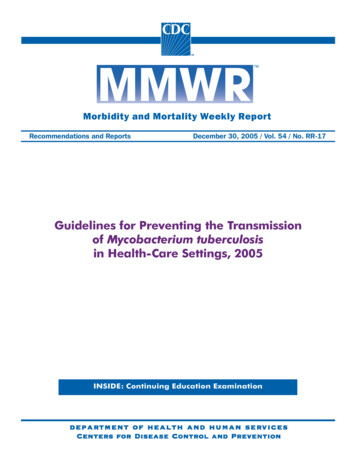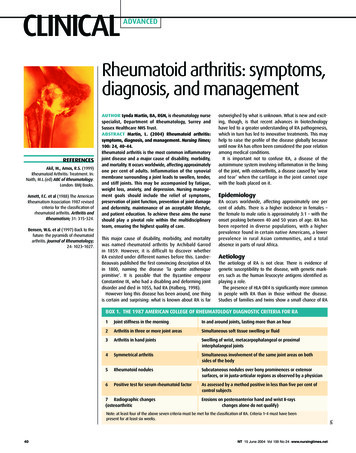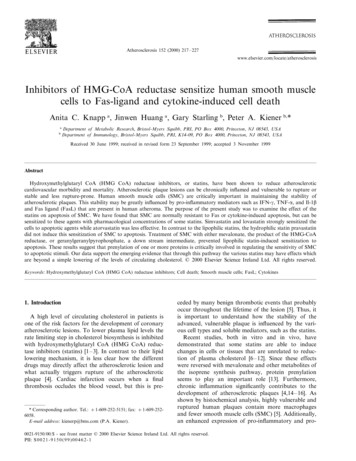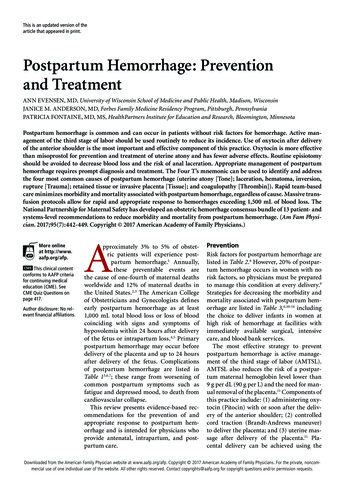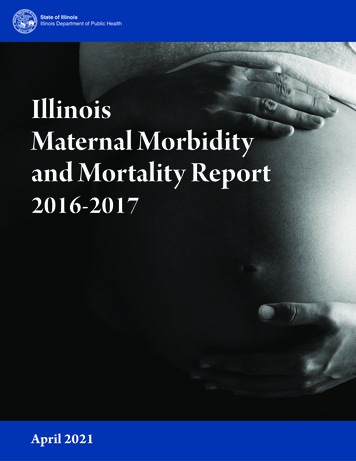
Transcription
State of IllinoisIllinois Department of Public HealthIllinois Maternal Morbidity and Mortality Report 2016-2017IllinoisMaternal Morbidityand Mortality Report2016-2017April 2021
Illinois Maternal Morbidity and Mortality Report 2016-2017Table of ContentsAcknowledgments . . . . . . . . . . . . . . . . . . . . . . . . . . . . . . . . . . . . . . . . . . . . . . . . . . . . . . . . . . . . . . . . . . . . . . . . . . . . . . . . . . . . . . . . . . . . . . 1Contributors . . . . . . . . . . . . . . . . . . . . . . . . . . . . . . . . . . . . . . . . . . . . . . . . . . . . . . . . . . . . . . . . . . . . . . . . . . . . . . . . . . . . . . . . . . . . . . . . . . . 2Letter from the Director . . . . . . . . . . . . . . . . . . . . . . . . . . . . . . . . . . . . . . . . . . . . . . . . . . . . . . . . . . . . . . . . . . . . . . . . . . . . . . . . . . . . . . . . . 5Executive Summary . . . . . . . . . . . . . . . . . . . . . . . . . . . . . . . . . . . . . . . . . . . . . . . . . . . . . . . . . . . . . . . . . . . . . . . . . . . . . . . . . . . . . . . . . . . . . 6Introduction . . . . . . . . . . . . . . . . . . . . . . . . . . . . . . . . . . . . . . . . . . . . . . . . . . . . . . . . . . . . . . . . . . . . . . . . . . . . . . . . . . . . . . . . . . . . . . . . . . . . 8The Importance of Maternal Health . . . . . . . . . . . . . . . . . . . . . . . . . . . . . . . . . . . . . . . . . . . . . . . . . . . . . . . . . . . . . . . . . . . . . . . . . . . . . . 9Redlining: Structural Roots of Inequity in Chicago . . . . . . . . . . . . . . . . . . . . . . . . . . . . . . . . . . . . . . . . . . . . . . . . . . . . . . . . . . . . . . . 11Chronic Disease During Pregnancy . . . . . . . . . . . . . . . . . . . . . . . . . . . . . . . . . . . . . . . . . . . . . . . . . . . . . . . . . . . . . . . . . . . . . . . . . . . . . 15Severe Maternal Morbidity . . . . . . . . . . . . . . . . . . . . . . . . . . . . . . . . . . . . . . . . . . . . . . . . . . . . . . . . . . . . . . . . . . . . . . . . . . . . . . . . . . . . . 21Maternal Mortality . . . . . . . . . . . . . . . . . . . . . . . . . . . . . . . . . . . . . . . . . . . . . . . . . . . . . . . . . . . . . . . . . . . . . . . . . . . . . . . . . . . . . . . . . . . . . 23Maternal Death Case Examples . . . . . . . . . . . . . . . . . . . . . . . . . . . . . . . . . . . . . . . . . . . . . . . . . . . . . . . . . . . . . . . . . . . . . . . . . . . . . . . . . 42Opportunities for Prevention . . . . . . . . . . . . . . . . . . . . . . . . . . . . . . . . . . . . . . . . . . . . . . . . . . . . . . . . . . . . . . . . . . . . . . . . . . . . . . . . . . . 46Recommendations . . . . . . . . . . . . . . . . . . . . . . . . . . . . . . . . . . . . . . . . . . . . . . . . . . . . . . . . . . . . . . . . . . . . . . . . . . . . . . . . . . . . . . . . . . . . . 49IDPH Commitment to Health Equity . . . . . . . . . . . . . . . . . . . . . . . . . . . . . . . . . . . . . . . . . . . . . . . . . . . . . . . . . . . . . . . . . . . . . . . . . . . 56Coronavirus Disease 2019 and Maternal Health Outcomes . . . . . . . . . . . . . . . . . . . . . . . . . . . . . . . . . . . . . . . . . . . . . . . . . . . . . . . 59Building Momentum in Maternal Health . . . . . . . . . . . . . . . . . . . . . . . . . . . . . . . . . . . . . . . . . . . . . . . . . . . . . . . . . . . . . . . . . . . . . . . . 61Appendix A: Resources for Women and Their Family and Friends . . . . . . . . . . . . . . . . . . . . . . . . . . . . . . . . . . . . . . . . . . . . . . . . . 64Appendix B: Resources for Health Care Providers and Hospitals . . . . . . . . . . . . . . . . . . . . . . . . . . . . . . . . . . . . . . . . . . . . . . . . . . 65Appendix C: Medical Terminology . . . . . . . . . . . . . . . . . . . . . . . . . . . . . . . . . . . . . . . . . . . . . . . . . . . . . . . . . . . . . . . . . . . . . . . . . . . . . . 66Appendix D: Methods Notes for Statistical Analyses . . . . . . . . . . . . . . . . . . . . . . . . . . . . . . . . . . . . . . . . . . . . . . . . . . . . . . . . . . . . . . 69April 2021
Illinois Maternal Morbidity and Mortality Report 2016-2017The Illinois Department of Public Health would like toacknowledge the 175 Illinois women who died whilepregnant or within one year of their pregnancy during2016-2017 and their loved ones.We hope our efforts to better understand the causes ofmaternal mortality in Illinois will help prevent otherwomen from suffering a similar fate.For more information:Contact the Illinois Department of Public Health, Office of Women’s Health and Family Services atDPH.MCH@illinois.gov.Suggested CitationIllinois Maternal Morbidity and Mortality Report, 2016-2017, Illinois Department of Public Health. (April 2021).FundingThe work represented in this report was funded by the Enhancing Reviews and Surveillance to Eliminate Maternal Mortality(ERASE-MM) program of the Centers for Disease Control and Prevention, grant number 5 NU58DP006682-02-00.Other SupportThe Illinois Department of Public Health acknowledges the support provided by the Centers for Disease Control andPrevention’s Maternal and Child Health Epidemiology Program (MCHEP) in the implementation of the state maternalmortality review process, data analysis, and preparation of this report.April 20211
Illinois Maternal Morbidity and Mortality Report 2016-2017ContributorsIllinois Department of Public Health StaffAmanda Bennett, PhD, MPH, Office of Women’s Health and Family Services *Cara Bergo, PhD, MPH, Office of Women’s Health and Family Services *Julie Doetsch, MA, Office of Policy, Planning, and StatisticsTanya Dworkin, JD, Office of Women’s Health and Family Services (former)Ngozi O. Ezike, MD, DirectorSonal Goyal, PharmD, MPH, Office of Women’s Health and Family Services *Trishna Harris, DNP, APN, WHNP-BC, CNM, Office of Women’s Health and Family ServicesAbigail Holicky, MPH, Office of Women’s Health and Family Services (former) *Ashley Horne, MSPH, Office of Women’s Health and Family Services (former)Shannon Lightner, MSW, MPA, Office of Women’s Health and Family Services *Jennifer Martin, MSW, Office of Health PromotionNancy Martin, Office of Policy, Planning, and StatisticsKenya McRae, JD, MPH, PhD, Office of Women’s Health and Family Services *Bria Oden, MPH, Office of Women’s Health and Family Services *Andrea Palmer, MPA, MBA, CHSM, Office of Women’s Health and Family Services (former)Miranda Scott, MBA, MALS, BSN, RN, LNC, Office of Women’s Health and Family ServicesMarcelo Seminara, BS, Office of Women’s Health and Family ServicesAlexander Smith, BA, Office of Women’s Health and Family ServicesEvonda Thomas-Smith, RN, MSN, Assistant Director (former)Kelly Vrablic, MPH, Office of Women’s Health and Family ServicesOther Report ContributorsLisa Cohen, MA, Illinois Department of Human ServicesAlisa Corrado, MD, Rush University Medical School *Karen Kasinger, MSN, APN, CPNP, Illinois Department of Healthcare and Family ServicesMadison Levecke, BS, University of Illinois at Chicago, School of Public Health *Rachel Newhouse, MS, CNM, Forensic Nursing and Nurse Midwifery, University of Illinois at ChicagoElizabeth Richards, BSN, RN, University of Illinois at Chicago, College of NursingTeri Ryals, MSN, BSN, RNC-OB, SANE-A, University of Illinois at Chicago, College of NursingSophie Shepley, BA, Washington University in St. Louis *Joanne Sorce, MSN, RNC-OB, Perinatal Network Administrator, University of Illinois at ChicagoAshley Walker, BSN, RN, University of Illinois at Chicago, College of NursingDawn R. Wells, BSN, RN, Illinois Department of Healthcare and Family ServicesCara Wolfe, BSN, RN, University of Illinois at Chicago, College of NursingGrace Yarnoff, BSN, RN, University of Illinois at Chicago, College of Nursing* Contributors to the writing, editing, and preparation of this reportApril 20212
Illinois Maternal Morbidity and Mortality Report 2016-2017Maternal Mortality Review CommitteeDuring Review of 2016-2017 DeathsChairRobin L. Jones, MD, Obstetrics and Gynecology, Rush University Medical CenterMembersRobert Abrams, MD, Maternal-Fetal Medicine, Southern Illinois UniversityTimika Anderson Reeves, PhD, MSW, Community Outreach, Access Family Health CenterDavid Arnolds, MD, Obstetric Anesthesiology, University of ChicagoKatherine Austman, MD, Family Medicine, Gibson Area HospitalJennifer Banayan, MD, Cardiac and Obstetric Anesthesiology, University of ChicagoDeborah Boyle, MD, FACOG, BSN, Maternal-Fetal Medicine, University of ChicagoJoan Briller, MD, FACC, FASE, FAHA, Cardiology with Obstetric Focus, University of Illinois at ChicagoStacey Chamberlain, MD, MPH, Emergency Medicine, University of Illinois at ChicagoStacie Geller, PhD, MPH, Women’s Health Research, University of Illinois at ChicagoAshley Horne, MSPH, Women’s Health Research, University of Illinois at ChicagoAshley Hunt, LCSW, MSW, Psychotherapist, Urban BalancePatricia Lee King, PhD, MSW, Quality Improvement, Illinois Perinatal Quality CollaborativeOlga Lazala, PhD, APN, CNS, CNM, RNC-OB, Nurse Midwifery, Advocate Health and University of Illinois at ChicagoKathryn Lindley, MD, Cardiology with Obstetric Focus, Washington University in St. LouisJerome Loew, MD, Pathology, Rush University Medical CenterGary Loy, MD, MPH, Maternal-Fetal Medicine, Rush University Medical CenterLisa Masinter, MD, MPH, MS, Obstetrics and Gynecology and Health Services Research, Alliance ChicagoPaula Melone, MD, Maternal-Fetal Medicine, Loyola UniversityNicole Miles, CLC, Doula, Chicago Volunteer DoulasFrank Nagorka, JD, EMT-P, Emergency Medicine and Attorney at LawHeather Nixon, MD, Obstetric Anesthesiology, University of Illinois at ChicagoBrielle Osting, AM, MPP, Community Advocacy, Meridian, a WellCare CompanyBeth Plunkett, MD, MPH, Maternal-Fetal Medicine and OB/GYN Research, NorthShore University HealthSystemKirbi Range, MS, Maternal and Child Health Programs, EverThrive IllinoisDonald Reese, MD, Family Medicine with Obstetrics, Gibson Area HospitalBarbara Scavone, MD, Obstetric Anesthesiology, University of ChicagoShirley Scott, MS, RN-BC, C-EFM, APN, Nursing and Perinatal Education, University of Illinois at ChicagoJennifer Seo, MD, JD, Medical Director, Chicago Department of Public HealthLee Smith, BA, Case Management, Sinai Community InstituteMichael Socol, MD, Maternal-Fetal Medicine, Northwestern UniversityPatrick Thornton, CNM, PhD, Nurse Midwifery, University of Illinois at ChicagoPaloma Toledo, MD, MPH, Obstetric Anesthesiology, Northwestern UniversityApril 20213
Illinois Maternal Morbidity and Mortality Report 2016-2017Maternal Mortality Review Committee for Violent DeathsDuring Review of 2016-2017 DeathsChairMaripat Zeschke, RNC-EFM, MSN, Perinatal Network Administrator, Rush University Medical CenterMembersThomas Barker, Law Enforcement, Chicago Police DepartmentAnn Borders, MD, MSc, MPH, Maternal-Fetal Medicine, NorthShore University HealthSystem, and Illinois Perinatal Quality CollaborativeDeborah Boyle, MD, FACOG, BSN, Maternal-Fetal Medicine, University of ChicagoKara Driscoll, MD, ABPN, Psychiatry, The Allegro CenterStacie Geller, PhD, MPH, Women’s Health Research, University of Illinois at ChicagoAshley Horne, MSPH, Women’s Health Research, University of Illinois at ChicagoWilnise Jasmin MD, MBA, MPH, Medical Director of Behavioral Health, Chicago Department of Public HealthKatherine Kane-Willis, MA, Policy and Advocacy, Chicago Urban LeagueJo Kim, PhD, Clinical Psychology, NorthShore University HealthSystemCarrie Klima, CNM, PhD, FACNM, Nurse Midwifery, University of Illinois at ChicagoJerome Loew, MD, Pathology, Rush University Medical CenterBahakia Madison, PsyD, Substance Use Counseling, Oakton Community CollegeDenise McCaffrey, BSW, Child Abuse Prevention, Prevent Child Abuse IllinoisMichele L. McCay, DrPH, MPH, Public Health, University of Illinois at ChicagoAnna McCormick, MD, FACEP, Emergency Medicine, Memorial Medical CenterCindy Mitchell, RN, BSN, MSHL, Perinatal Network Administrator, St. John’s HospitalRachel Newhouse, MS, CNM, Forensic Nursing and Nurse Midwifery, University of Illinois at ChicagoBarbara Parilla, MD, Maternal-Fetal Medicine and Addiction Medicine, Rush University Health SystemBernadette Ray, MD, Family Medicine, Gibson Area HospitalJaclyn Rodriguez, BSN, BS, RN, SANE-A, Sexual Assault Nurse Examiner, Office of the Illinois Attorney GeneralSheila Sanders, BS, Outreach and Education, EverThrive IllinoisShirley Scott, MS, RN-BC, C-EFM, APN, Nursing and Perinatal Education, University of Illinois at ChicagoLita Simanis, LCSW, Social Worker, AMITA Health, Alexian Brothers Health SystemVickie Smith, BA, Domestic Violence Prevention and Services, Illinois Coalition Against Domestic ViolenceAmber Truehart, MD, MSc, Obstetrics and Gynecology, Family Planning Specialist, University of ChicagoTeresa Tudor, BS, Domestic Violence Prevention and Services, Illinois Department of Human Services, Bureau of Domestic Violence,Sexual Assault and Human TraffickingCarole Warshaw, MD, Psychiatry, National Center on Domestic Violence, Trauma and Hektoen Institute for Medical ResearchPerinatal Network AdministratorsRoma Allen, DNP, MSN-Ed, RNC-OB, Loyola University Medical CenterDaniell Ashford, DNP, MBA, NE-BC, RNC-OB, CEFM, FNP-BC, LNC, Northwestern Memorial HospitalPeggy Cowling, APN, MSN, RNC-OB, C-EFM, CHSE, University of Chicago MedicineAndrea Cross, RN, BS, MSHA, Cook County Health and Hospital SystemJodi Hoskins, DNP, MSN-Ed, RNC, Javon Bea HospitalCindy Mitchell, RN, BSN, MSHL, St. John’s HospitalElaine Shafer, APN, MSHA, MS-PSL, OSF Healthcare System dba Saint Francis Medical CenterJoanne Sorce, MSN, RNC-OB, University of Illinois at ChicagoConnie Thompson, MSN-Ed, RNC-OB, C-EFM, SSM Cardinal Glennon Children’s HospitalMaripat Zeschke, RNC-EFM, MSN, Rush University Medical CenterApril 20214
Illinois Maternal Morbidity and Mortality Report 2016-2017525-535 West Jefferson St re et S p r i n g f i e l d , I l l i n o i s 6 2 76 1 - 0 0 0 1 w w w. d p h . i l l i n o i s . g o vDear Colleagues,The Illinois Department of Public Health (IDPH) is honored to share this second edition of the IllinoisMaternal Morbidity and Mortality Report. This report builds on the important work of two IDPHcommittees, the Maternal Mortality Review Committee (MMRC) and the Maternal Mortality ReviewCommittee for Violent Deaths (MMRC-V), which was captured in Illinois’ first ever report on maternalmorbidity and mortality and released in 2018. The first report included detailed statewide data andrecommendations that would help prevent maternal morbidity and mortality, while also improving theoverall health of women of reproductive age. We are humbled at the response to the first report. Electedofficials, community leaders, medical providers, foundations, and everyday Illinoisans have raised theirvoices and become deliberate in their efforts to lift this work in a collaborative, focused way.The goal of this second report is to continue identifying statewide patterns in maternal health andproviding recommendations directed at key stakeholders to prevent maternal mortalities andmorbidities. Additionally, this report expands the discussion to include factors that play a role inmaternal health and contribute to the health disparities and inequities observed in Illinois’ maternalhealth outcomes. This discussion, as difficult as it may be, is absolutely essential if we want to be seriousabout our mission to improve health outcomes for all women, children, and families.IDPH recognizes the work is not by any means complete; in fact, we are just beginning. The MMRC andMMRC-V, which are subcommittees of the Perinatal Advisory Committee (PAC), an advisory board toIDPH, will continue their work and are currently reviewing the maternal deaths that occurred in 2018.They will continue identifying and examining the social determinants of health that detrimentallyimpact the health of women of color, and in particular Black women. We at IDPH are committed to aculture of health equity, and we are committed to working collaboratively with our partners to haveIllinois be the healthiest state for all women.IDPH cannot thank enough the dedicated volunteers who serve on the MMRC and the MMRC-V fordevoting their time and expertise to this mission critical work. Working together, our efforts willcontinue to move Illinois forward in ensuring Illinois women have the best health outcomes possible.In continuous service,Ngozi Ezike, MDDirectorApril 20215
Illinois Maternal Morbidity and Mortality Report 2016-2017Executive SummaryMaternal mortality (death) is an important measure for assessing the overall health of a community. Given the increaseover time and persistent racial/ethnic disparities in maternal mortality in the United States, it is vital that we betterunderstand the causes of and contributors to this public health crisis.Using a variety of data sources, the Illinois Department of Public Health (IDPH) identifies all deaths of women whilepregnant or within one year of pregnancy (pregnancy-associated deaths). IDPH convenes two maternal mortality reviewcommittees (MMRCs), which review specific cases of maternal death to identify the causes of death, determine whetherthe deaths were pregnancy-related (occurred due to a pregnancy complication, a chain of events initiated by thepregnancy, or the aggravation of an unrelated condition by the physiologic effects of pregnancy), determine whether thedeaths were preventable, and develop recommendations to prevent future deaths. The two MMRCs reviewed 129maternal deaths that occurred during 2016-2017 to develop the recommendations in this report.Key Findings:An average of 75 Illinois women died while pregnant or within one year of pregnancy each year during 2008-2017, withthe highest number recorded in 2017 (a total of 103 deaths).In 2016-2017: 34% of women who died while pregnant or within one year of pregnancy died from a cause related to pregnancy. The leading cause of pregnancy-related death was mental health conditions, including substance use disorders,which comprised 40% of pregnancy-related deaths. The next three most common causes of pregnancy-relateddeath were pre-existing chronic medical conditions that were exacerbated by pregnancy, hemorrhage, andhypertensive disorders of pregnancy. Black women were about three times as likely to die from a pregnancy-related condition as White women. Black women were more likely to die from pregnancy-related medical conditions while White women were morelikely to die from pregnancy-related mental health conditions. One-third of pregnancy-related deaths occurred more than two months after pregnancy. The MMRCs determined that 83% of the pregnancy-related deaths were potentially preventable. 85% of the pregnancy-associated deaths by suicide and 35% of the pregnancy-associated deaths by drug overdosewere determined to be pregnancy-related. The MMRCs determined that nearly all the pregnancy-associated homicide, suicide, and drug overdose deathswere potentially preventable.April 20216
Illinois Maternal Morbidity and Mortality Report 2016-2017Highlights of Key Recommendations: Health insurance plans, including Illinois Medicaid, should reimburse for telehealth, including phone-basedservices, regardless of patient or provider location. The state and collaborating programs should expand and facilitate coordination of home visiting programs forpregnant and postpartum women with complex medical or mental health conditions, regardless of income, whocould benefit from additional support or care coordination. The state should expand implementation of promising practices for improving maternal outcomes andempowering women to engage with health care providers, such as home visiting for all women within threeweeks of giving birth and doula support. Hospitals should participate in the upcoming statewide birth equity quality improvement initiative with theIllinois Perinatal Quality Collaborative and should provide training and resources to staff on racism, implicit bias,stigma related to substance use disorder, and trauma-informed care. Hospitals should establish policies and protocols to ensure appropriate treatment of pregnant or postpartumwomen with substance use disorders and support opioid overdose prevention. Providers should ensure that following delivery, all women are discharged from the hospital with an appointmentfor an early postpartum visit with an obstetric care provider within the first three weeks postpartum, followed bya comprehensive postpartum visit no later than 12 weeks postpartum. Providers should seek consultation when prescribing, changing, or discontinuing anti-depressants or otherpsychotropic medications during pregnancy, and that they ensure the patient is connected to mental healthservices in addition to medication therapy.1 Community-based organizations should educate women on the importance of getting prenatal care early inpregnancy to improve healthy pregnancy outcomes and increase opportunity to optimally parent her child. It is important that all women have an annual well-woman visit with a primary care provider to identify andmanage any chronic conditions, and to discuss how to be as healthy as possible before or between pregnancies. Itis also important for women with a recent pregnancy to reconnect with, or establish care with, a medical homefor continued medical care beyond the postpartum visit.1Maternal Mental Health: Depression and Anxiety. (February 2016). Council of Patient Safety in Women’s Health Care. Retrieved -and-anxiety/April 20217
Illinois Maternal Morbidity and Mortality Report 2016-2017IntroductionIn 2018, the Illinois Department of Public Health (IDPH) released its first ever report on maternal morbidity andmortality.2 This report described maternal deaths in Illinois, including where they occurred, what caused them, and whowas most affected. The report also specifically highlighted the unacceptably high rates of pregnancy-related deaths forBlack women. Since the release of that report, there has been an increased focus on maternal mortality in Illinois: The General Assembly introduced several bills incorporating recommendations from the report, and many weresigned into law by Gov. JB Pritzker. Illinois was the first state in the nation to extend full Medicaid benefits from 60 days to 12 months postpartum,following the federal Centers for Medicare & Medicaid Services (CMS) approval in April 2021. The IllinoisDepartment of Healthcare and Family Services (HFS) submitted an Medicaid 1115 demonstration waiver topermit continuous eligibility through 12 months postpartum. CMS approval of the waiver enables federalmatching dollars to implement this Medicaid expansion. This was a key recommendation from the first IllinoisMaternal Morbidity and Mortality Report to improve continuity of care for women. Using data and recommendations from the report, entities in the state were awarded highly competitive nationalgrants aimed at improving maternal health outcomes. More details about these grants are provided in the“Building Momentum in Maternal Health” section of this report. Birthing hospitals incorporated recommendations from the report into quality improvement initiatives toimprove maternal health outcomes. IDPH staff members and Maternal Mortality Review Committee (MMRC) leadership presented maternalmortality data and recommendations to local, state, and national audiences, reaching approximately 1,500people. The objective of these presentations was to increase awareness of opportunities to improve maternalhealth outcomes.This report will build upon the first report by presenting updated data on maternal deaths and providing specificrecommendations that the MMRCs developed when reviewing deaths occurring during 2016-2017. This report will alsoprovide additional context to the many factors involved in maternal mortality in Illinois. It is important to note that someof the findings from this report are not directly comparable to findings from the first report due to changes in methods.More details are provided in each section and are available in Appendix D.2Illinois Maternal Morbidity and Mortality Report. (October 2018). Illinois Department of Public Health.April 20218
Illinois Maternal Morbidity and Mortality Report 2016-2017The Importance of Maternal HealthMaternal health, or the health of a woman3 during pregnancy, childbirth, and the postpartum period, is importantbecause of the rapid physical and psychological shifts during this time that can have longstanding effects on a woman’slife. For example, chronic conditions can be exacerbated by the physiologic stress of pregnancy and new pregnancyrelated health conditions may arise. Women typically have more interaction with health care providers during pregnancyand increased access to health and social services during pregnancy. Therefore, pregnancy and the postpartum periodprovide an opportunity to identify, treat, and manage conditions to improve a woman’s overall health.Maternal Health in IllinoisAccording to the July 2019 American Community Survey, Illinois is the sixth most populous state in the United Stateswith 12.7 million residents, including 2.5 million women of reproductive age (15-44 years).4 Illinois women deliverapproximately 140,000 births annually. The state is racially and ethnically diverse, with approximately 54% of births tonon-Hispanic White women, 17% to non-Hispanic Black women, 21% to Hispanic5 women, and 8% to non-Hispanicwomen of other races. It is also geographically diverse, with both large urban areas and sparsely populated ruralcommunities, each with unique barriers to health care.Maternal Health as a ContinuumHealth outcomes during the perinatal and postpartum period occur across a continuum (Figure 1). Most women arehealthy during pregnancy, meaning they experience a typical outcome with no complications. However, some womenexperience pregnancy complications, which may be minor or severe, and may cause significant short- and/or long-termconsequences to a woman’s health. Severe complications are rare, with a relatively small number of women experiencingthe most severe complication: death.Figure 1: The Continuum of Maternal y Moms3IDPH understands and recognizes that not all people who have been pregnant or given birth identify as being a “woman.” This report uses the term “women”instead of “people” or “persons” as an intentional device to highlight the vulnerability of people who society typically identifies as being female. The use of"women" is not intended to exclude or silence those who do not identify as female, but to draw attention to the ways pregnant or postpartum people arediscriminated against because of their female gender assignment at birth.4Annual Estimates of the Resident Population for Selected Age Groups by Sex for Illinois: April 1, 2010 to July 1, 2019 (2020) United States Census Bureau American.Retrieved February 18, 2021 from o/popest/2010s-state-detail.html5IDPH acknowledges that multiple terms may be used to describe the Hispanic population, including Latino or Latinx. A Pew Research Center study in 2020reported that 69% of U.S. adults with Hispanic or Latino origins prefer the term “Hispanic,” 29% preferred “Latino” and 4% preferred r-u-s-hispanics/). IDPH has opted to use “Hispanic” throughoutthis report because it was the most preferred term.April 20219
Illinois Maternal Morbidity and Mortality Report 2016-2017Maternal morbidity (pregnancy complications) and maternal mortality (death) are two indicators often used to assessthe overall health status of a community. Although still relatively rare, maternal mortality in the United States has beenincreasing and is 3 to 4 times higher than other developed nations.6 However, not all women are at equal risk of dying. Inthe United States, between 2014-2017 pregnancy-related mortality ratios were three times higher for Black women thanWhite women.7While health insurance and availability of services can be major barriers to care, many other social and systemic issuesaffect the health gap between Black and White persons. It is now recognized that health is not merely the result of anindividual’s biology or genetics, but is influenced by a myriad of other factors, such as education, wealth, and racism.Opportunities and access to information can affect decision-making and the health behaviors of women. Laws andpolicies can create unequal distribution of resources and power that may leave some groups of people disadvantaged. Thesocial, political, and economic structures that produce inequities, combined with the lived, everyday experiences ofindividuals, are known as “social determinants of health.” Examples of social determinants of health that deeply affect awoman’s ability to thrive and to be healthy include poverty, quality of education, health literacy, employment, housing,availability of child care, transportation, community support, and neighborhood safety.It is particularly important to note that structural racism is a driving force of the social determinants of health. Structuralracism is defined as “normalization and legitimization of an array of dynamics – historical, cultural, institutional, andinterpersonal – that routinely advantage Whites while producing cumulative and chronic adverse outcomes for people ofcolor.”8 Structural racism affects many aspects of society, including the health care system. The next section will provideone specific example of how structural racism affects the quality of life and health of Black women in Chicago through apractice called “redlining.”6K
During Review of 2016-2017 Deaths Chair Maripat Zeschke, RNC-EFM, MSN, Perinatal Network Administrator, Rush University Medical Center . MD, Family Medicine, Gibson Area Hospital Jaclyn Rodriguez, BSN, BS, RN, SANE-A, Sexual Assault Nurse Examiner, Office of the Illinois Attorney General . an advisory
